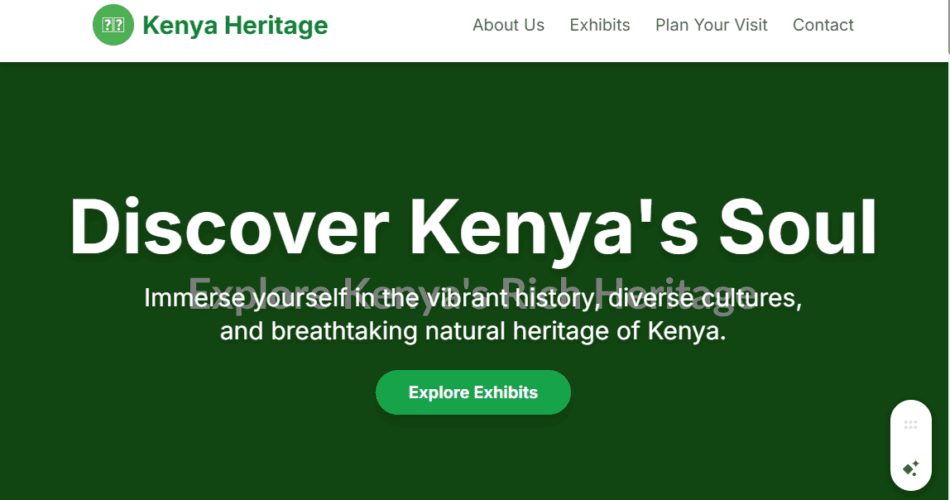SEO for Museum Websites in Kenya
- Delivery Time2 Weeks
- English levelProfessional
- LocationUSA, United Kingdom, United Arab Emirates, New York, Nairobi, Kilimani, Kenya, Dubai, CBD Nairobi, Canada, Australia
Service Description
The cost of SEO for Museum Websites in Kenya 80000KES per month.Get SEO for Museum Websites in Kenya at a price of 30000KES per month at Black Shepherd Technologies.
Explore Kenya’s rich heritage at [Museum Name]. Discover ancient artifacts, stunning art, and captivating exhibits. Plan your visit to our Nairobi location today.
A successful SEO strategy for a Kenyan museum website should be multifaceted, focusing on both on-page and off-page elements. The goal is to make the website a valuable resource that not only informs potential visitors but also establishes the museum as a leading authority in its field.
1. Keyword Research: Understanding Your Audience
The foundation of any good SEO strategy is thorough keyword research. For a museum in Kenya, this means identifying the terms people use to find information about history, art, culture, and specific attractions in the region.
Branded Keywords: These are terms that include your museum’s name, such as “Nairobi National Museum” or “Karen Blixen Museum.” It’s essential to rank #1 for these, which is typically straightforward.
Unbranded Keywords: These are broader terms related to your content but not your specific institution. Examples include “museums in Nairobi,” “archaeological sites in Kenya,” “Kenyan art history,” or “prehistoric sites near Lake Turkana.” These keywords have higher search volume and are critical for attracting new visitors.
Local Keywords: Given that museums are physical locations, local SEO is paramount. Keywords like “what to do in Mombasa,” “family day out Nairobi,” or “Fort Jesus ticket prices” are vital for driving foot traffic. Use tools like Google Keyword Planner to find terms with a good balance of high search volume and low competition.
2. On-Page SEO: Optimizing Your Website
On-page SEO involves optimizing individual web pages to rank higher and earn more relevant traffic.
High-Quality, Engaging Content: The content on your museum’s website is your biggest asset.
Exhibit Pages: Create detailed, visually rich pages for each exhibition and collection. Use high-quality images and videos. The text should be informative and easy to read, with clear headings and subheadings.
Blog/News Section: A blog is an excellent way to target a wider range of keywords. Write articles on topics related to your collections, such as “The History of the Swahili Coast,” “Famous Kenyan Artists,” or “The Role of Archaeology in Kenya.” This establishes your authority and provides fresh content for search engines to crawl.
Visitor Information: This page is non-negotiable. Clearly list your opening hours, location, ticket prices, and contact information. Make sure this information is easy to find on both desktop and mobile.
Use of Keywords: Naturally integrate your researched keywords into your page titles, headings (H1, H2, H3), and body text. Avoid “keyword stuffing,” which can harm your rankings.
Technical SEO:
Website Speed: A slow website frustrates visitors and can negatively impact your search rankings. Optimize images, use a good hosting service, and consider using a Content Delivery Network (CDN) to improve loading times, especially for users in Kenya and East Africa.
Mobile-Friendliness: Most web traffic in Kenya comes from mobile devices. Your website must be responsive and provide a seamless experience on smartphones and tablets.
Structured Data: Use schema markup to help search engines understand your content better. For a museum, this could include markup for events, location, and visitor reviews.
Internal Linking: Link from your blog posts to relevant exhibit pages and vice-versa. This helps search engines understand the structure of your site and keeps visitors engaged for longer.
3. Local SEO: Connecting with the Community
Local SEO is arguably the most important aspect for a physical institution like a museum.
Google Business Profile (GBP): Claim and optimize your Google Business Profile. This is the information box that appears on the right-hand side of Google search results. Ensure all information is accurate and up-to-date:
Name, address, and phone number (NAP)
Opening hours
Website link
High-quality photos of the museum, exhibits, and staff
Encourage visitors to leave reviews. Respond to all reviews, both positive and negative.
Local Directories: List your museum on relevant Kenyan and international business directories and travel sites. This creates valuable “citations” that help validate your business to search engines.
Location-Specific Content: Create content that is highly relevant to your location. For example, a blog post titled “Top 5 Museums to Visit in Mombasa” would be perfect for Fort Jesus.
4. Off-Page SEO: Building Authority
Off-page SEO involves actions taken outside of your website to impact your rankings.
Link Building: Getting other reputable websites to link to yours is a powerful signal of authority.
Partnerships: Collaborate with local universities, historical societies, and tourism boards. They may be willing to link to your website.
Press Releases: When you have a new exhibition or event, send out press releases to local news outlets. A link from a reputable news site can significantly boost your SEO.
Content Promotion: Promote your blog posts and other content on social media to increase visibility and attract backlinks.
Social Media: While not a direct ranking factor, a strong social media presence drives traffic and engagement. Use platforms like Instagram, Facebook, and Twitter to showcase your collections, announce events, and interact with your community.
In conclusion, SEO is no longer a luxury but a fundamental necessity for museums in Kenya seeking to fulfill their mission in the digital age. The successful digital strategy for these institutions hinges on a nuanced understanding of the local market, the technological behaviors of their audience, and the unique value they offer. By prioritizing a well-crafted SEO plan, museums can transcend their physical walls and become accessible, educational, and engaging resources for a global audience.
The key to success lies in a synergistic approach that integrates robust on-page and off-page SEO with a deep commitment to creating high-quality, culturally relevant content. A strong local SEO presence, powered by an optimized Google Business Profile and location-specific content, will drive essential foot traffic. Meanwhile, a content strategy that uses storytelling, multimedia, and user-generated content will build a loyal online community and attract organic traffic from a broader range of interests.
As the digital landscape in Kenya continues to evolve with increasing internet penetration and smartphone usage, museums that embrace a proactive and data-driven SEO strategy will be the ones that not only survive but thrive. They will be able to effectively compete for online attention, secure their position as vital custodians of heritage, and ensure that Kenya’s rich cultural narrative reaches a new generation of enthusiasts, researchers, and tourists, both at home and abroad.








